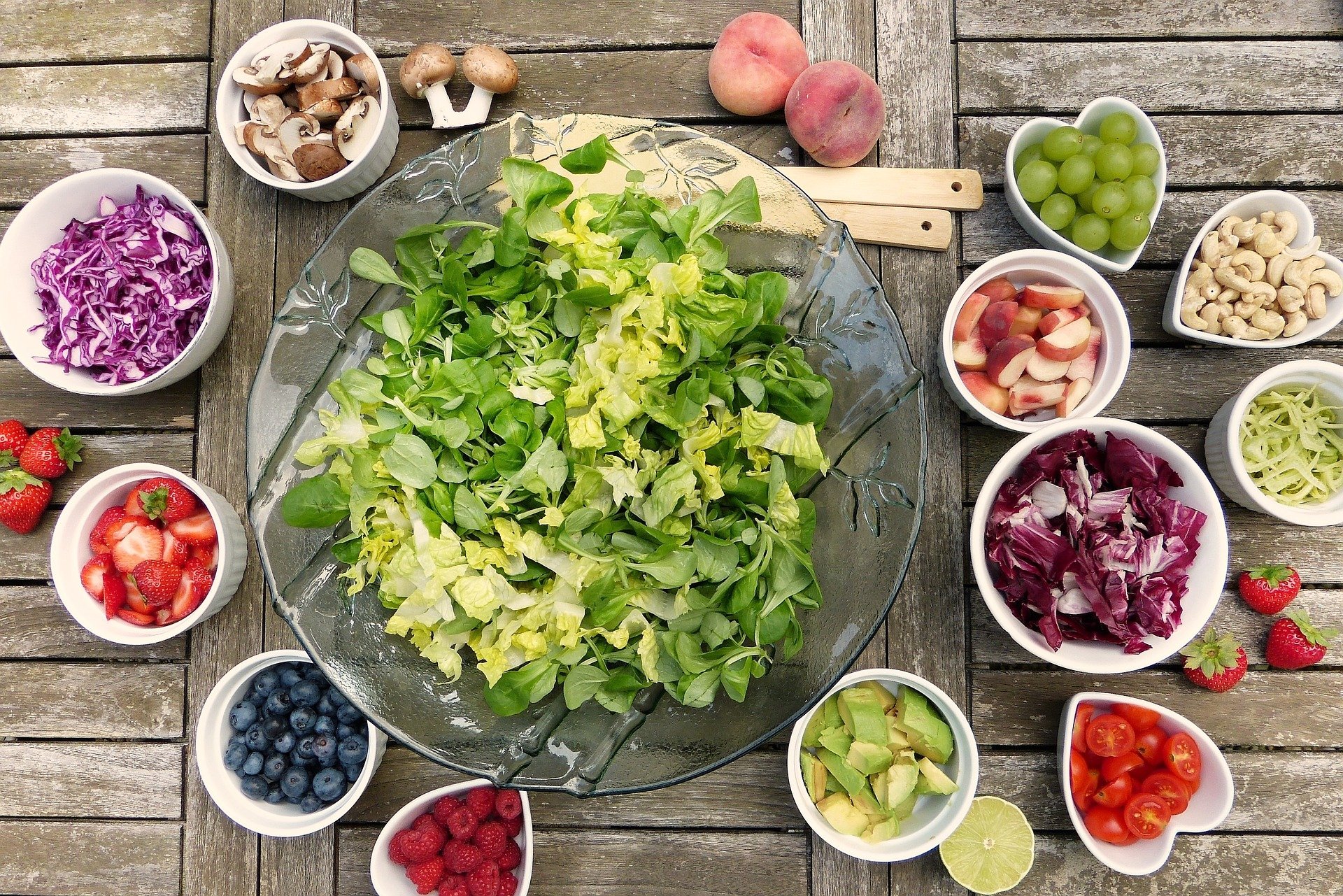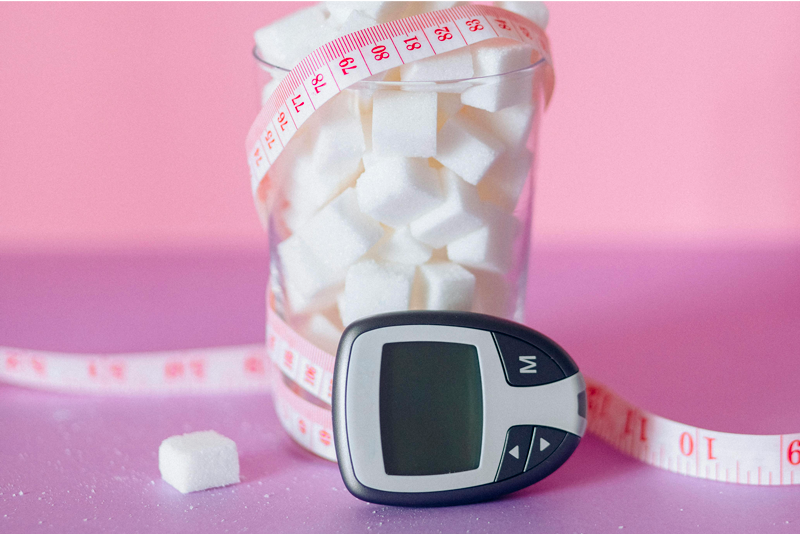
Genetic predisposition plays a key role in the development of type 2 diabetes. However, heredity is not the only cause of this disease. There are other risk factors to watch out for, in particular lifestyle and eating habits. But what are the best food habits to adopt in order to prevent diabetes? Which foods should be favoured and which should be avoided on a daily basis? Here is our advice.
It is possible to eat differently
Focus on fruit and vegetables
A diet rich in vegetables could reduce the risk of developing type 2 diabetes by 60%. It was evidenced in a study conducted in 2019 on more than 2,700 young adults (https://nutrition.org/research-reveals-how-diet-influences-diabetes-risk/). This does not necessarily mean opting for a completely vegetarian or vegan diet. While eating meat (especially lean meats such as turkey or chicken) and fish from time to time, it is advisable to eat a balanced diet with more fresh fruit, vegetables, whole grains, vegetable oils and nuts. Some of these are rich in protein, which makes them satiating. For example, 100 grams of almonds contain 21.2 grams of protein (https://tools.myfooddata.com/). This is much more than some meat products such as chorizo, bacon and leg of lamb, which contain 13.6%, 13.7% and 17.9% protein respectively.
Cooking: a healthy pleasure
Eating industrial or fried food is a risk factor for type 2 diabetes. Between March 2006 and October 2010, British researchers examined the eating habits of 350,000 individuals (https://www.thelancet.com/journals/lanplh/article/PIIS2542-5196(18)30208-0/fulltext). Their observations led them to the following conclusions: on average, a city dweller living near one or more fast-food outlets (e.g., a fast-food restaurant, a mobile pizzeria, a chip shop, an ice cream parlour or a hot dog stand) has an increased risk of developing diabetes. This is particularly true when these places are located within one kilometre of the place of residence. In this case, there is an 11% increase in diabetes. In combination with risk factors such as being overweight or sedentary, the consumption of industrial food (i.e., rich in simple sugars and additives) represents a concrete health hazard. Therefore, to prevent the development of type 2 diabetes, it is preferable to eat as many home-cooked meals as possible, using fresh and seasonal ingredients.
Which products should be avoided ?
Refined grains
Some processed foods have a high glycaemic index (or GI). This causes a sudden rise in blood sugar levels and prompts the pancreas to produce insulin. These notably include :
- microwave popcorn, which has a GI of 85 out of 100 (https://balance-glycemique.diabete.fr/balance)
- sandwich bread (70),
- baguette (70),
- boiled polenta (70),
- non-wholemeal pasta (61),
- Chinese noodles (65),
- basmati rice (58),
- and couscous seed (55).
Because of their above-average glycaemic index, these products have one thing in common: they are not recommended for diabetics or pre-diabetics (https://www.hsph.harvard.edu/nutritionsource/carbohydrates/carbohydrates-and-blood-sugar/). This applies not only to refined grains, but also to a large number of starchy dishes such as baked potatoes (95 out of 100), mashed potatoes (91) and gnocchi (68). In this regard, a 2007 Chinese study showed that a diet based on high-GI products could increase the chances of developing the disease by 21% in certain subjects (https://jamanetwork.com/journals/jamainternalmedicine/article-abstract/413531).
Bad fats
Learning to distinguish between the different types of fat can help improve the health of people with pre-diabetes. Here are the three families of fats to be aware of :
- les acides gras trans présents dans la friture, la margarine, la viande de bœuf et les pâtisseries industrielles (par exemple les biscuits, les beignets, rans fatty acids found in fried foods, margarine, beef and industrial baked goods (e.g., biscuits, doughnuts, cakes and pastries) ;
- saturated fatty acids found in palm oil, coconut oil and most animal fats ;
- monounsaturated fatty acids (or Omega-9) found in vegetable oils such as hazelnut, olive, avocado, almond, rapeseed and apricot kernel oil ;
- and finally polyunsaturated fatty acids (Omega-3 and Omega-6) found in oily fish (such as mackerel and sardines) as well as in walnut, grape seed, linseed and sesame oil.
According to several authors (https://www.health.harvard.edu/staying-healthy/the-truth-about-fats-bad-and-good), a diet low in trans fatty acids and saturated fatty acids is conducive to better health. These fats are partly responsible for the onset of diabetes in some pre-diabetics. Monounsaturated and polyunsaturated fatty acids, on the other hand, have a role to play in a balanced diet.
Sweetened drinks
Artificially sweetened drinks are very popular in Europe, where the average adult consumes 95 litres per year (https://www.nature.com/articles/s41387-019-0102-0#ref-CR7). However, these products can contain a lot of sugar. Some cans of soft drinks contain 39 grams (the equivalent of 7 cubes) of sugar. To avoid insulin spikes, it is therefore essential to avoid :
- sodas,
- sweet iced teas,
- energy drinks,
- industrial fruit juices,
- sports drinks (intended to be drunk before intensive sports training), which are by definition very rich in fructose.
Of course, going without sugary liquids does not prevent you from consuming hot drinks such as herbal tea, tea and coffee.
What foods should I choose ?
Wholegrain and semi-wholegrain cereals
Preventing diabetes requires the consumption of cereals with a low glycaemic index, including :
- toasted muesli for breakfast (with a GI of 43 out of 100),
- wholegrain bread (43),
- dark rye bread (41),
- and steamed whole wheat grains (41).
For durum wheat pasta, the glycaemic index of egg noodles is only 40, compared to 61 for traditional recipes without eggs.
Pulses
Pulses, or legumes, are a family of foods with a low glycaemic index, which makes them interesting for blood sugar regulation. Ideally, therefore, flageolets (31), chickpeas (32) and navy beans (35) should replace potatoes and sandwich bread in a pre-diabetes diet. Of all the legumes readily available on the market, the best score in terms of glycaemic index comes from kidney beans: with a GI of only 28 out of 100, this product can be used to create menus that will be both satiating and healthy.
Green vegetables
On a daily basis, a high intake of green vegetables is a good tool for preventing diabetes. According to many researchers (including the authors of this British meta-study from 2010: https://www.sciencedaily.com/releases/2010/08/100819214607.htm), this is due to their antioxidant properties and the magnesium they contain. A 180 gram plate of spinach, for example, contains 157 milligrams of magnesium, which covers more than a third of an adult’s daily requirement. Since a diet low in magnesium is a risk factor for type 2 diabetes (ph.harvard.edu/nutritionsource/magnesium/#:~:text=RDA%3A%20The%20Recommended%20Dietary%20Allowance,310%2D320%20mg%20for%20women), it is necessary to add leafy vegetables such as spinach to a pre-diabetic diet, but also :
- Swiss chard (which contains 86 milligrams of magnesium per 100 grams of vegetable),
- beetroot tops (70 mg per 100 g),
- artichokes (60 mg),
- rocket (47 mg),
- kale (33 mg),
- leeks (28 mg),
- or collard greens (27 mg).
To get the most out of the nutrients in these vegetables, they should be stored in a cool place, eaten quickly after purchase and enjoyed raw whenever possible. It is best to avoid frying, breading or boiling them for a long time (unless the cooking water is then consumed as a broth). It is better to use healthy methods of preparation such as wok cooking (without adding fat), plancha cooking or steaming. In addition to preserving the nutritional qualities of vegetables, steaming enhances their taste, texture and even their colour.
There is no need to start a strict diet to prevent type 2 diabetes. On the contrary, the prevention of this disease requires a thorough rebalancing of the diet, which will allow the pre-diabetic to discover a whole range of new flavours and recipes.
Our latest publications
Want to learn more about topics related to blood sugar management?
Here are our most recent blog posts!




Very useful information for diabetes prevention. Thanks for the post!